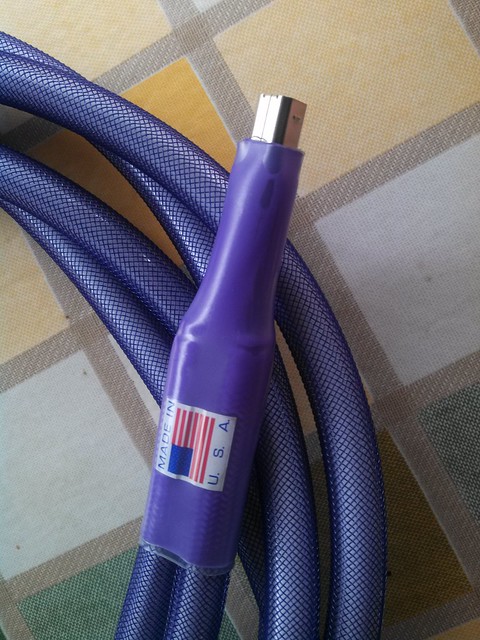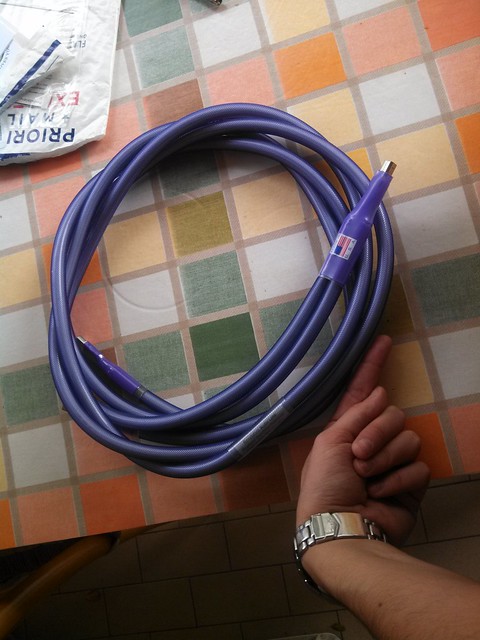An unfortunate turn of events, prevents me from advicing anyone towards buying from Revelation Audio Labs.
After purchasing his usb cable, I have requested a pair of XLR cables and paid in advance. This happened on 24th November 2013. To this day, it’s almost 4 months, and Brad’s last answer to me dates to 3rd February 2014.
The cables were initially purposed to be shipped on the same weekend of payment (four months ago).
I am honestly worried I will never see those XLR cables. I have asked him for a refund, and didn’t receive an answer either.
If any change happens, I will update this content accordingly.
2015-07-03: I simply wanted to add that Brad still hasn’t refunded me, nor others (see a thread on Head-fi.org and elsewhere on internet), and that’s he has been ignoring my emails for months. How to screw his reputation for a few hundred dollars.
Tony
– –
I got interested in the RAL USB cable after reading the impressions of a knowledgeable audiophile, member of several forums like Computer Audiophile or Stereo.au.net. I then also noticed that the RAL cable was strongly recommended on Offramp website, and I decided to contact Brad from Revelation Labs to purchase a unit. The package, unfortunately, has been slowed down by the local Customs and took over one month to reach my destination.
Anyway, the cable arrived safely and I put it immediately in my system.
Test Gear:
– Sources: Metrum Octave Mk2
– Speaker system: upgraded Meitner MTR-101 power monoblocks, custom preamplifier, Mordaunt Short Performance 6 speakers
– Headphone systems: Modified SRM-001 (baby) Stax amplifier and SR-001 Mk2 in-earspeakers; CKKIII and Etymotic ER4

Cable structure:
The Revelation Audio Labs Prophecy Dual Conduit usb cable (“the RAL cable” from here on) is a twin usb cable, like the Forza Audioworks I reviewed some time ago and the Acoustic Revive usb I have mentioned in some former articles.
In fact, the Prophecy was one of the first USB cables to have been engineered for separating the digital signal from the usb power signal.
The most apparent thing differentiating the RAL from any other usb cables I have tried (twin or not), is its size. If you ignore the delicate, purple colour, this is the most manly usb cable I have seen. Each branch section is as thick as a power cord. It’s huge, as you can see in the picture, and very stiff.
The reason for such properties, is that the cable uses solid core silver for the conductors, aimed to obtain the purest signal possible. Hence, the rigid structure is both needed for dampening the cable and for not damaging it cable during placement and usage.
Unfortunately, the cable has the worst ergonomics of anything I have ever seen: it needs some active force to be rotated correctly and be connected to the USB-SPDIF converter or DAC, and it will easily lift a tiny box (such a Jkenny Ciunas), which won’t stay flat on a surface.
I have used it in my Windows 8 based desktop PC and laptop. I connected it by plugging both usb connectors (signal only, power only) in the pc’s two USB ports. I also tried connecting the power end to a USB Trent battery, but the battery couldn’t stay on, hence, being incapable of recognizing the RAL.

Listening Impressions:
The main effect of the RAL cable is that it tightens the midbass, while retaining the deep bass energy, and improves imaging clarity and spatial placement. The changes have been especially ‘observable’ through my speaker setup, improving transparency and letting the Mordaunt-Short show more precisely where the instruments were been played, giving a bit more treble quantity.
One other effect of the cable is that the overall volume is slightly lowered (hence making me turn the volume knob of my preamp a little bit higher). The midbass/deep bass ratio gets better and makes the bass feel tighter, more earthy and taming some resonance of the Metrum / room combination.
In the high frequencies, compared to a generic usb cable (which came with the Antelope Audio dac), there is a bit more strength around 7-8 kHz. Given the range, I tried hard to detect any potential risk of sibilance, without finding any. Also, the high frequency range, manages to gain definition without generating problems of artificialness nor fake details. This is also helped by a dark DAC such as the Metrum Octave.
I have put my Mordaunt Short Performance 6 speakers in a relatively small room, which is about 20 square meters. I have rearranged the room in the best way to let them express. They are very adaptable and not too fussy about the room, still, with the stock usb cable and the Metrum DAC, I was still hearing some residual resonance in the midbass.
The Metrum Octave must be a good specimen for pairing with the RAL, since it’s a very smooth, natural sounding DAC which enjoys the treble increase and better midbass resonance control offered by the RAL cable.
To an extent, and by stretching imagination, I felt like the addition of the RAL was behaving like a feedback circuit in my audio system with the Metrum, capable of detecting such resonances of my Metrum/smallish room pairing and actively getting rid of them.
Having heard the VH Audio RCA diy solid core interconnect, the RAL cable contributes to the system with exactly the same sonic signature, with similar addition of upper midrange richness and bass control, without sounding piercing.
Given the totally different domain and purpose (usb digital signal), it would be interesting to understand how “well built conductors” interacts with jitter, compared to the less engineered USB cables, from a physical point of view.
It must be reported that I lent the RAL to other people, and in many of their systems (most often based on Mac sources), the cable didn’t work. Several sources have been used, such the AMR DP-777 or Eximus. In my system I I haven’t had any problems, but the cable should be tried before bought.
Conclusion:
The RAL Prophecy Dual Conduit doesn’t spoil much in the tonality while improving traits like detail positioning, mid-low linerity, background blackness. It lets the deep bass go through a bit more apparently in a set of speakers without subwoofers like mine, by polishing the midbass. It has the same kind of impact an analogue cable can have in a system. It has problems associated to reliability in certain systems, high cost, and bad ergonomics, which make it not suitable to use in living rooms, but it can make sense with DAC’s that have very sensitive USB inputs, and that enjoy separation on signal and power line, and have a warm sound signature to start with. Then, a good, even if expensive USB cable would prevent the user from buying a separate, more expensive USB-SPDIF interface, impact less on the total cost of the system, and make for a worthwhile purchase.


